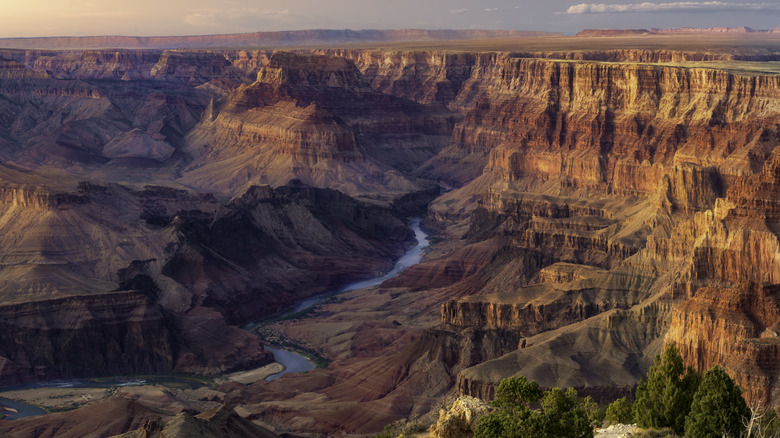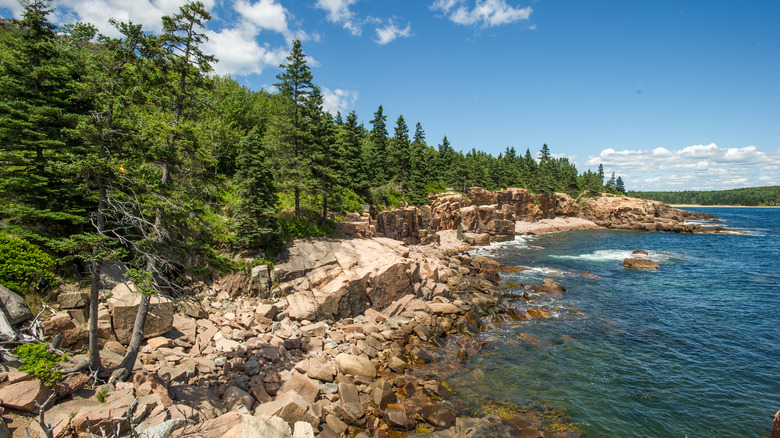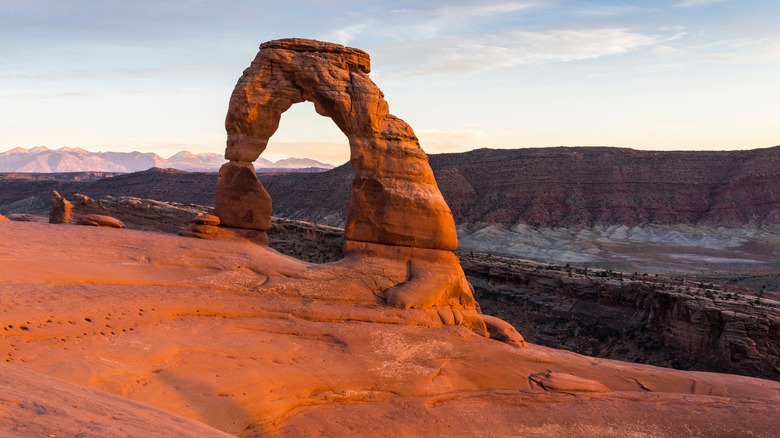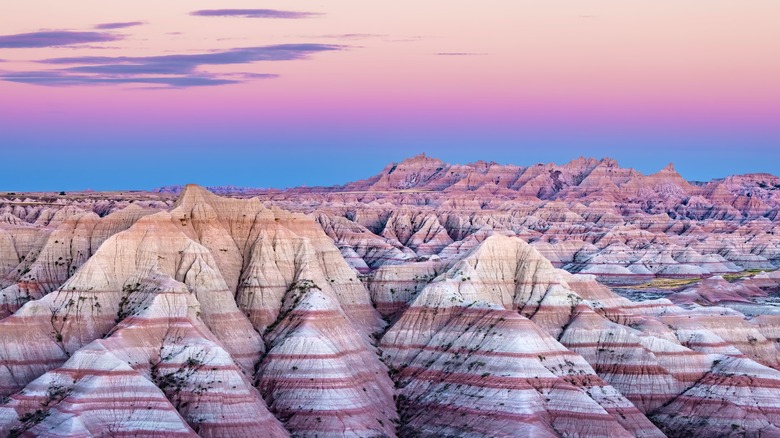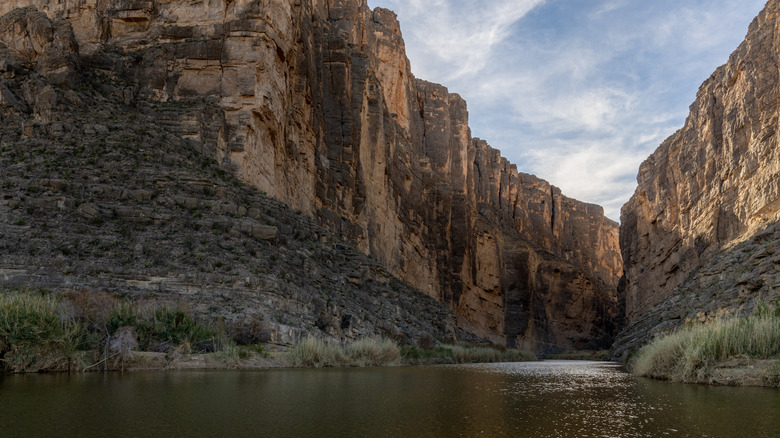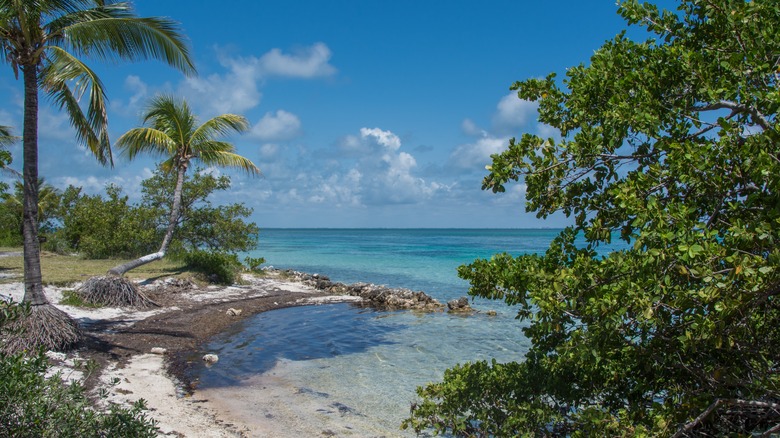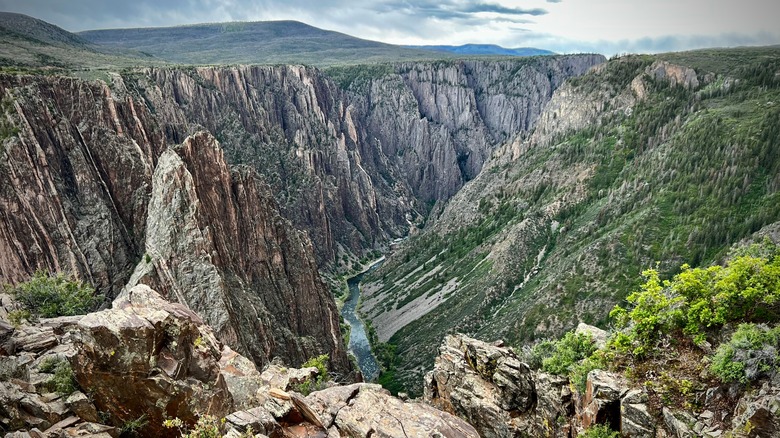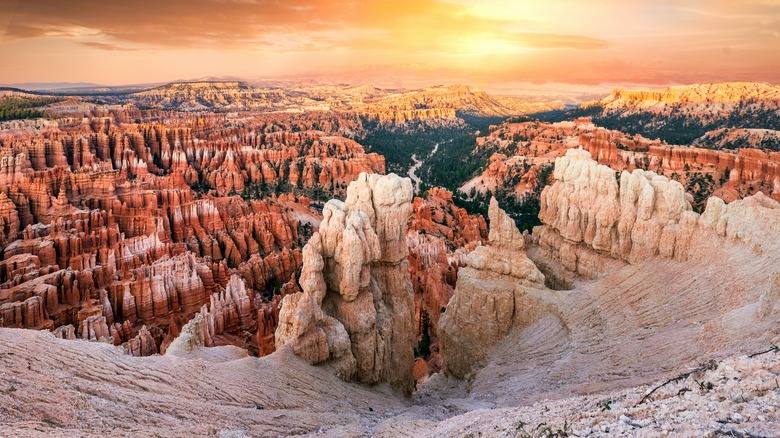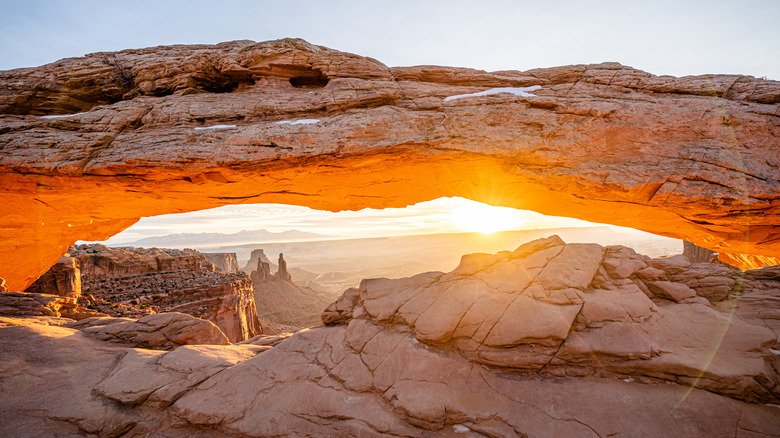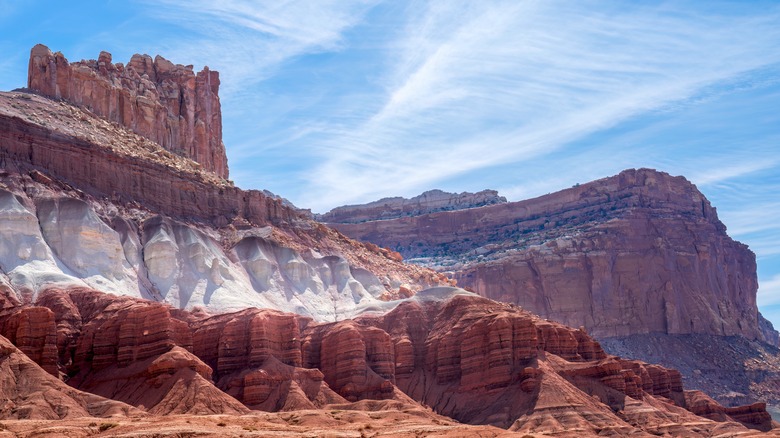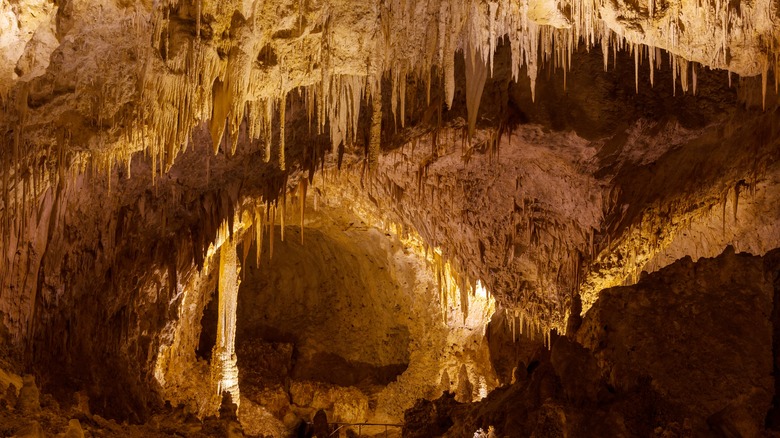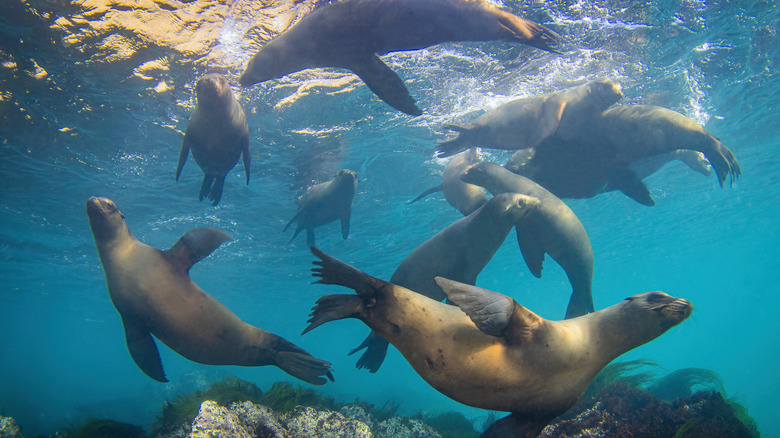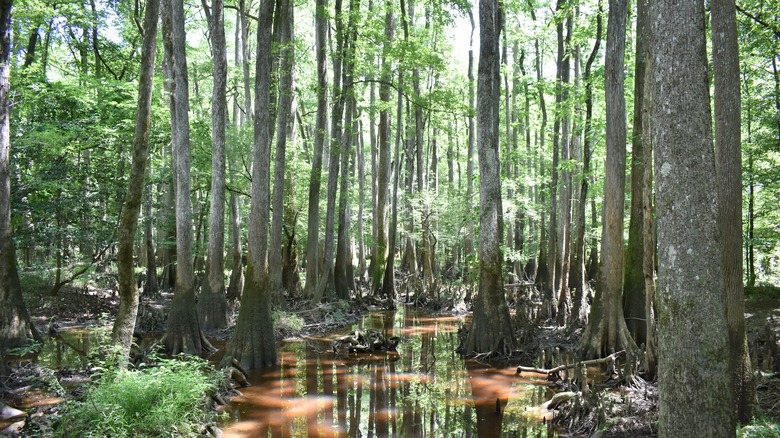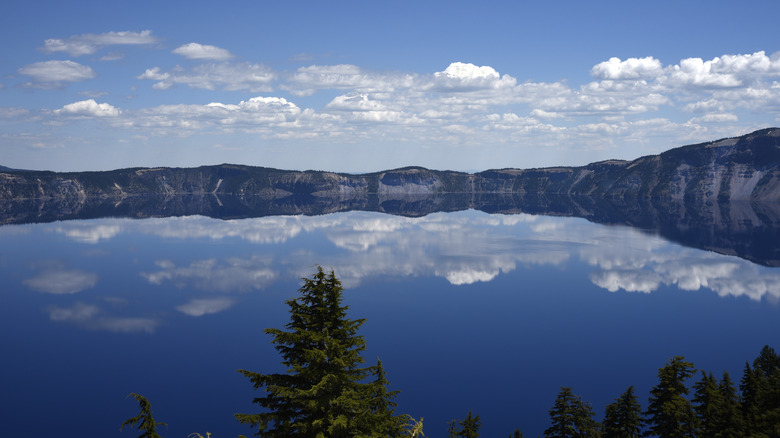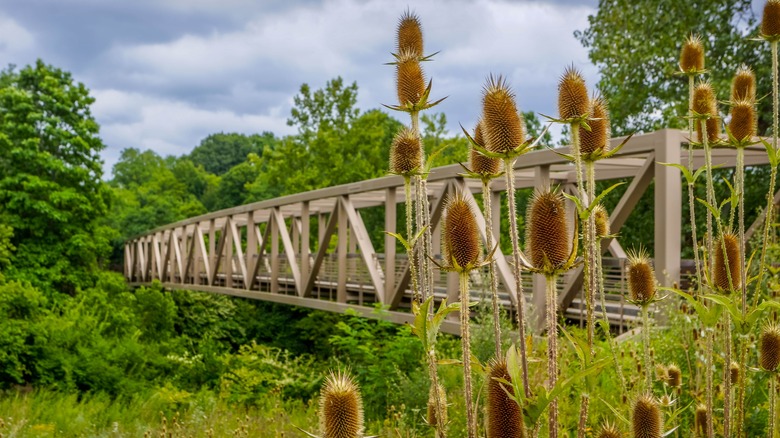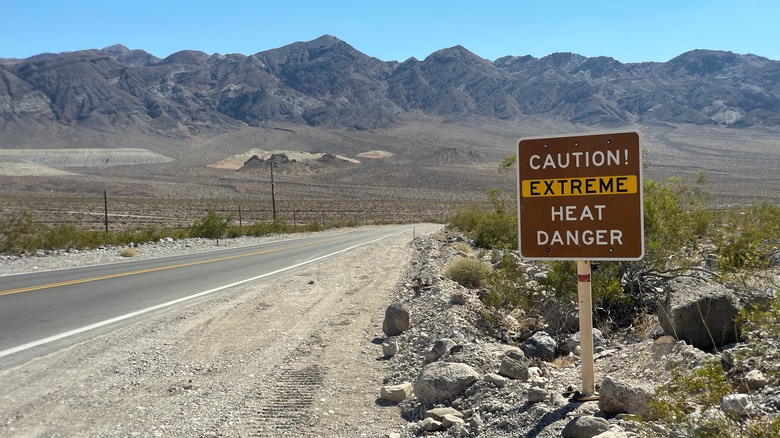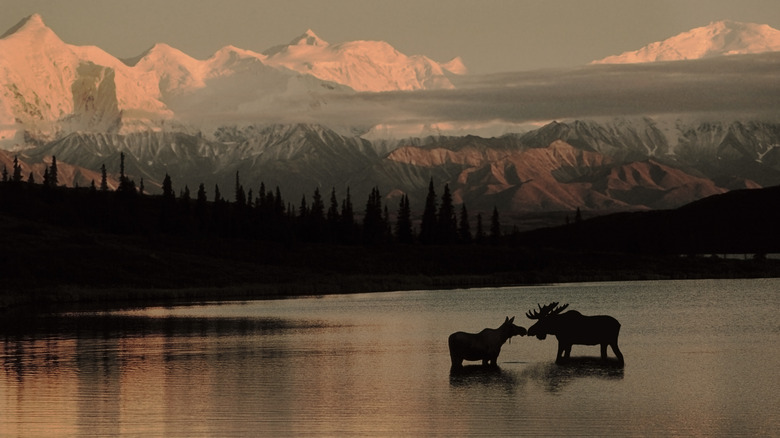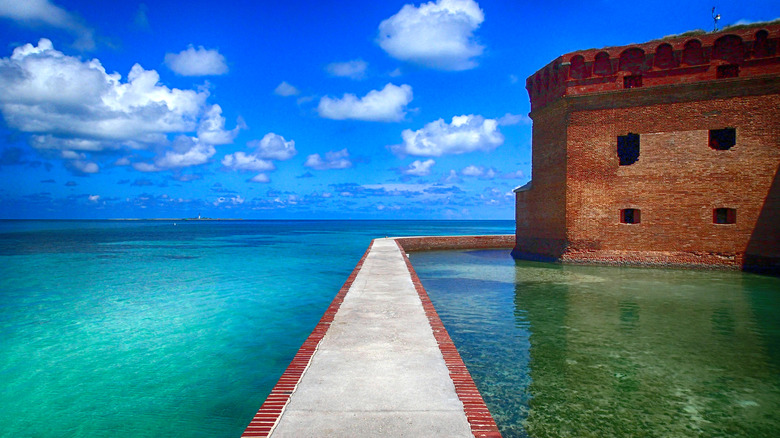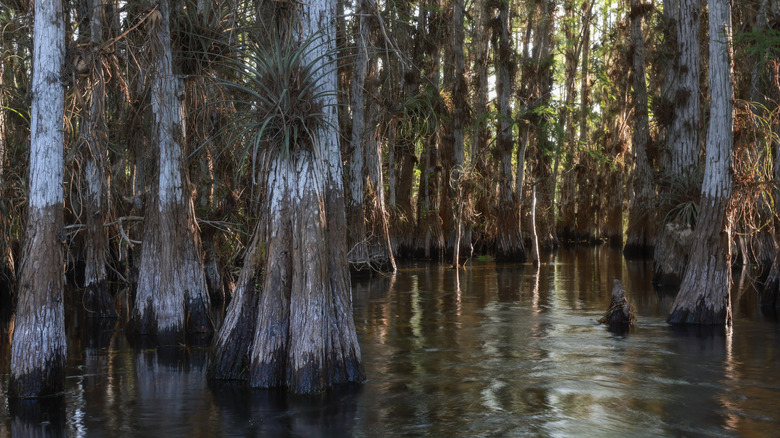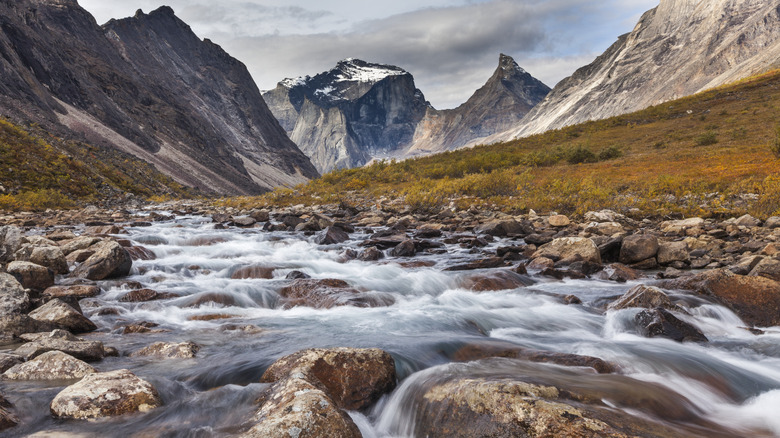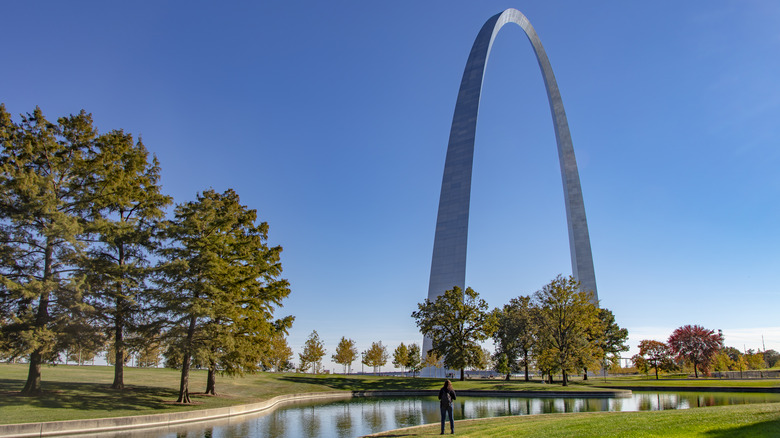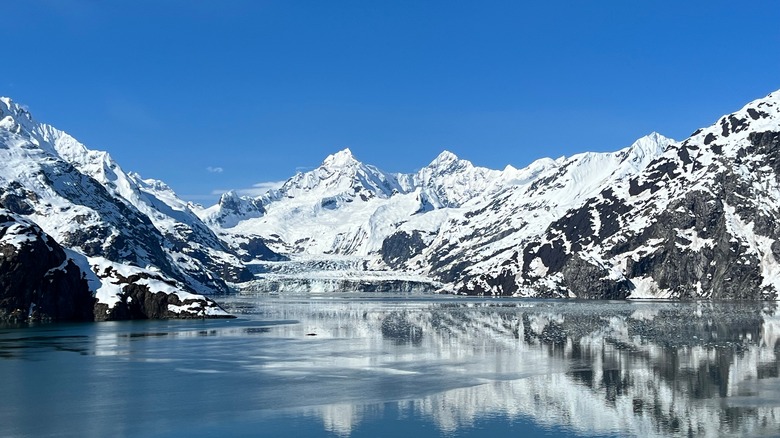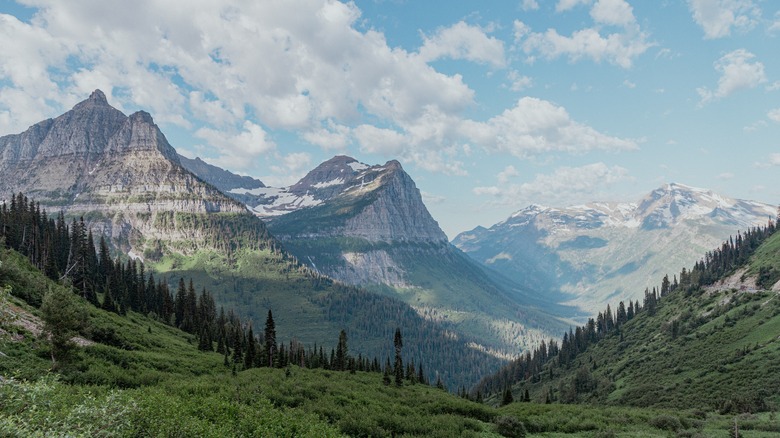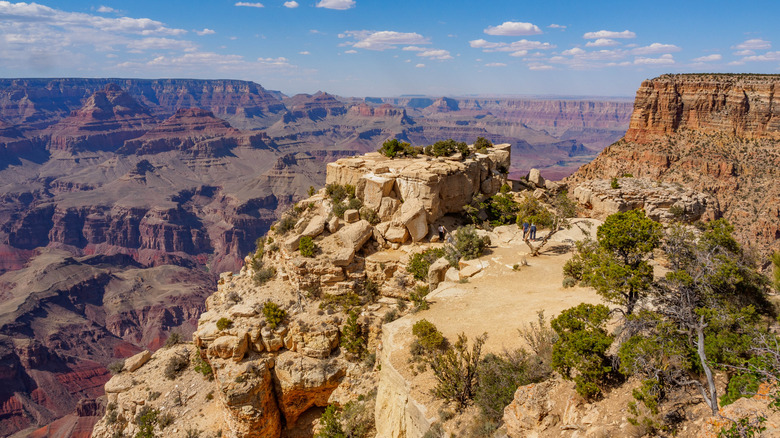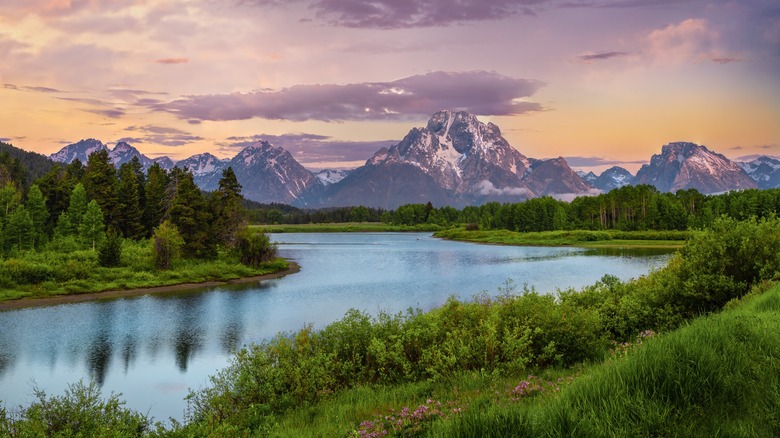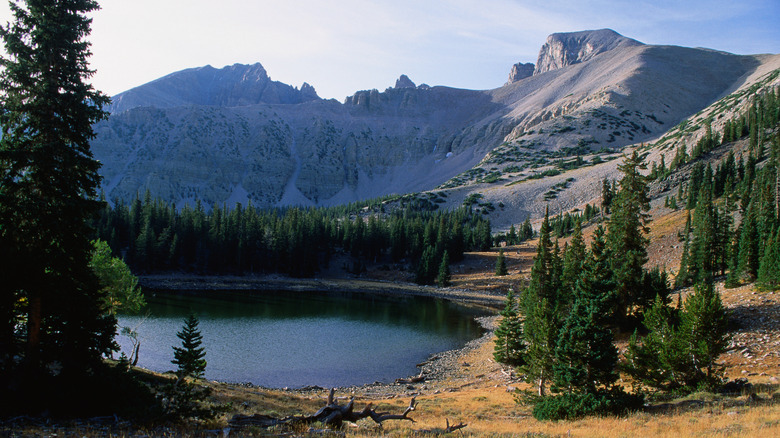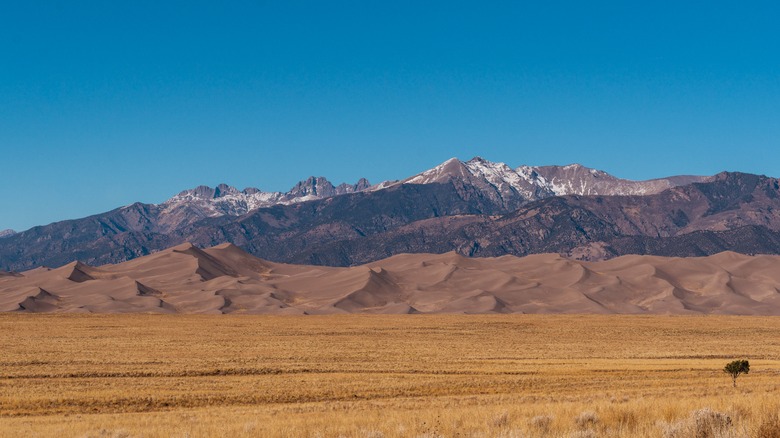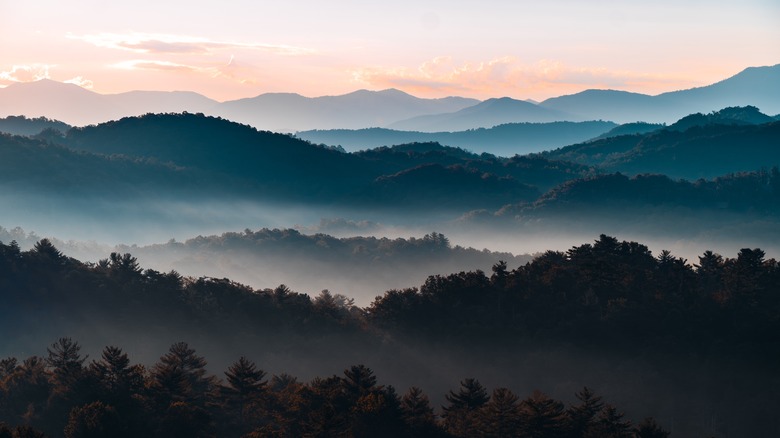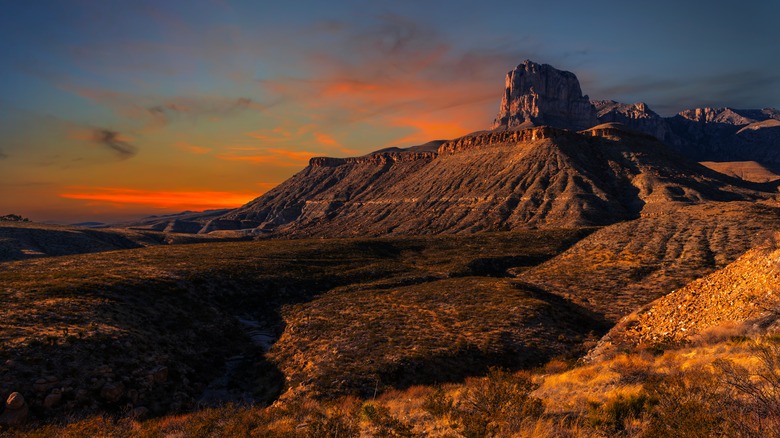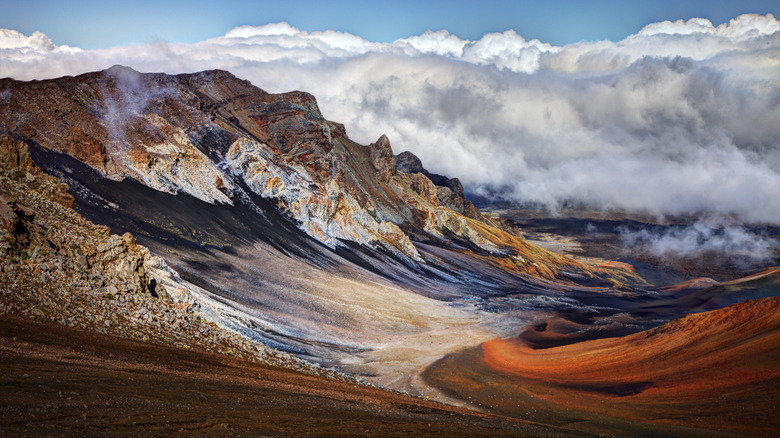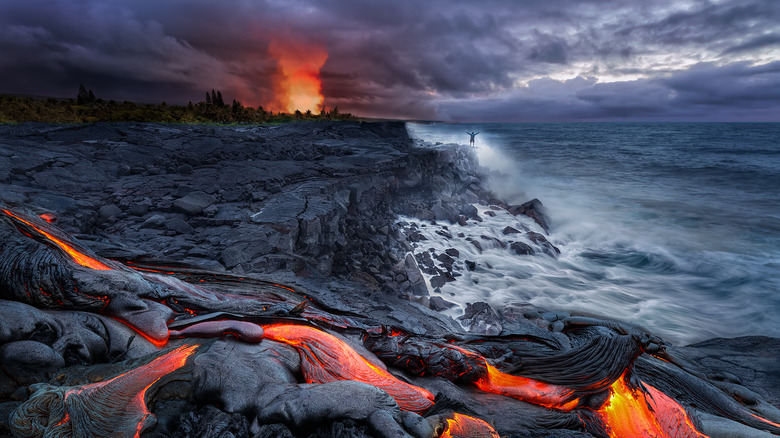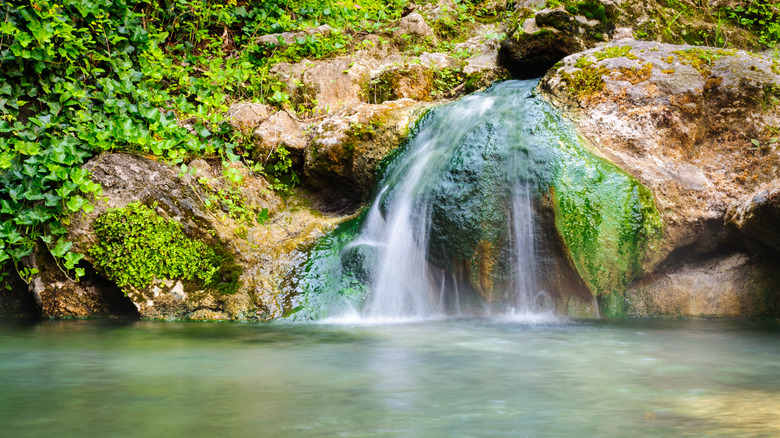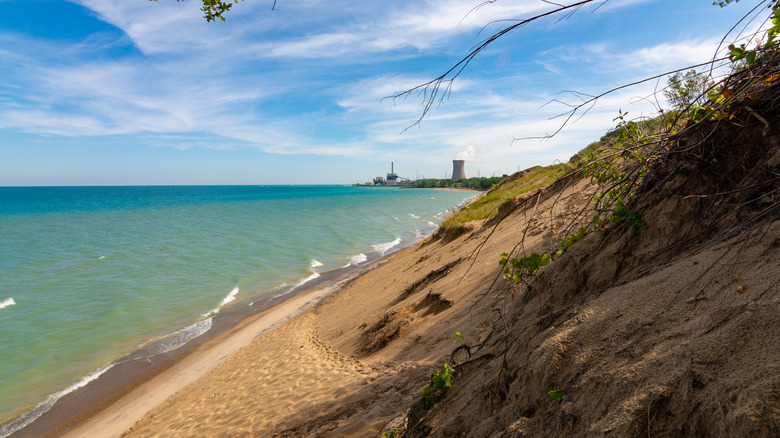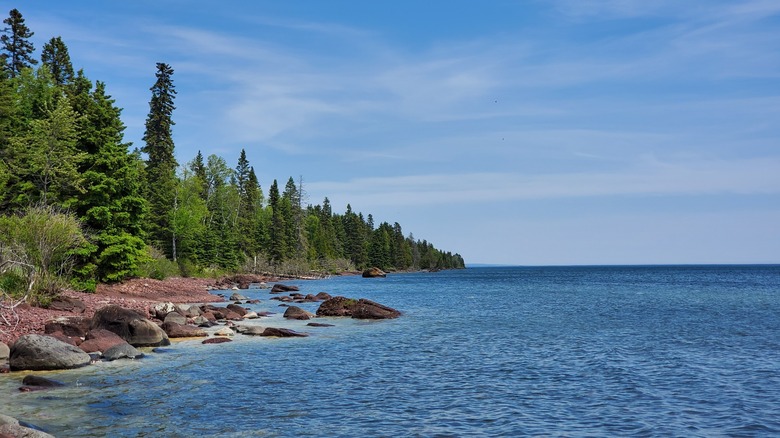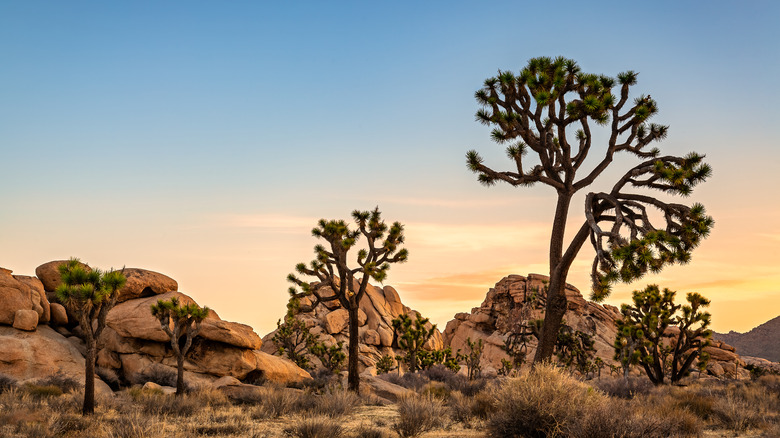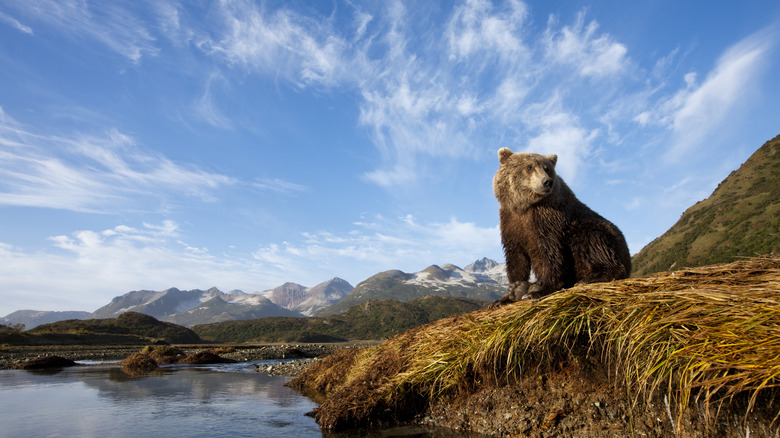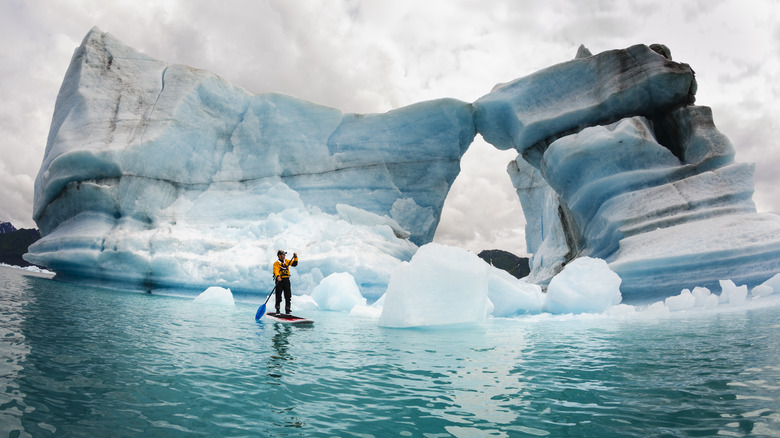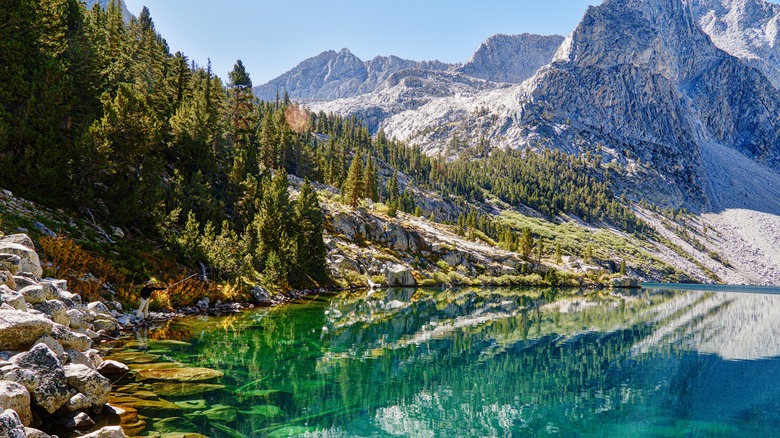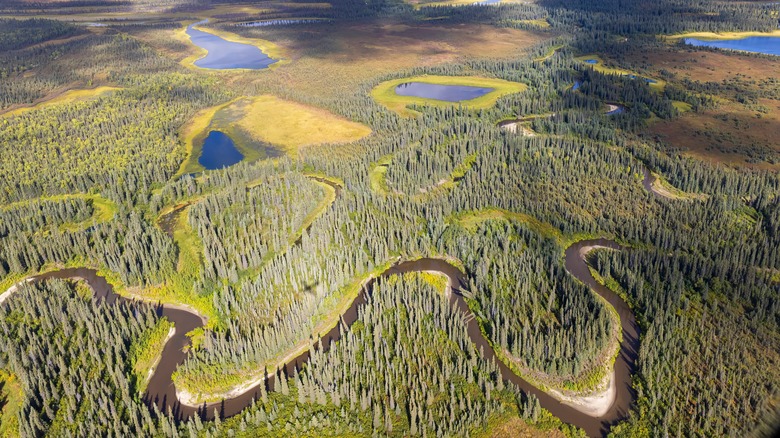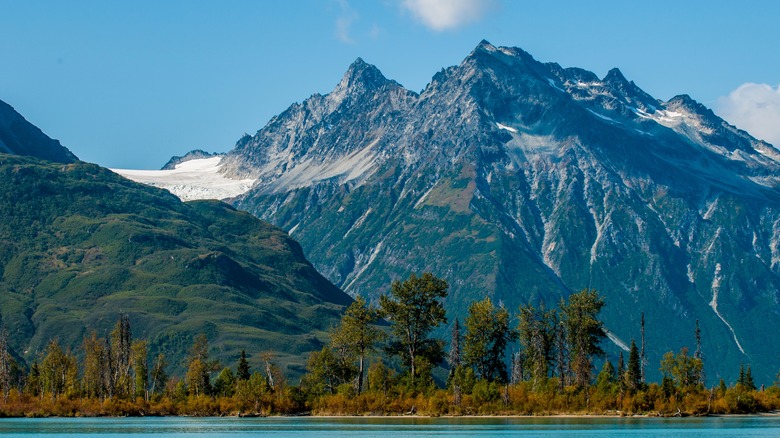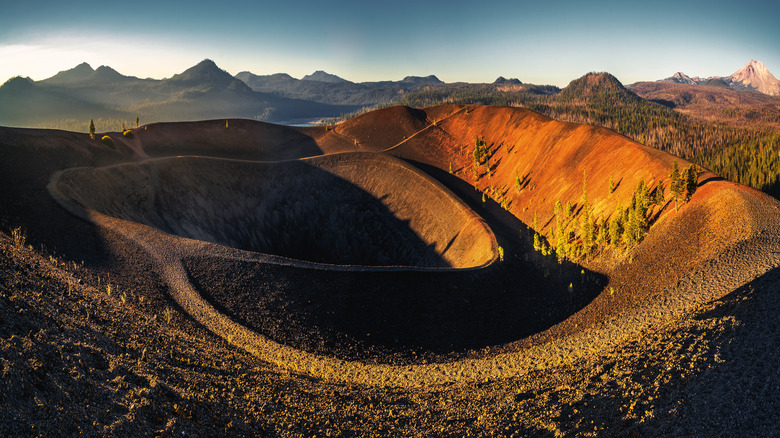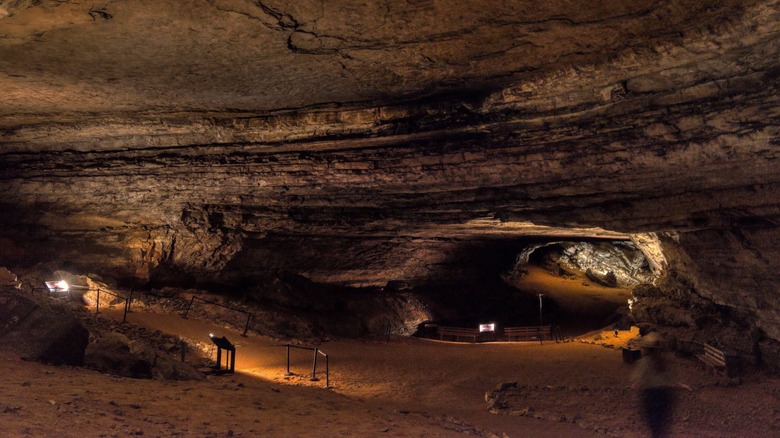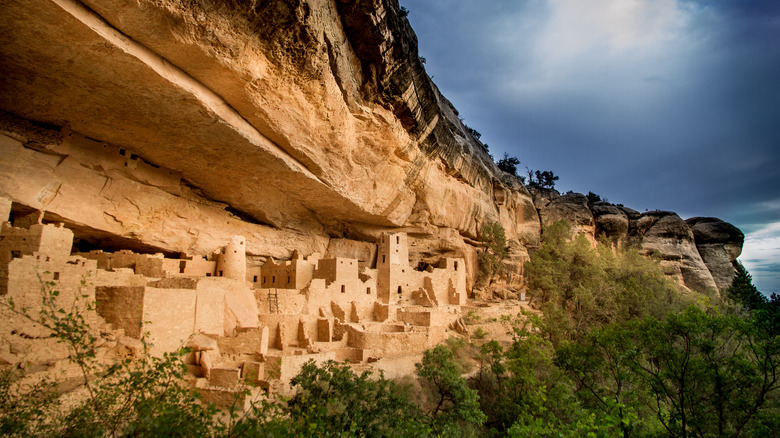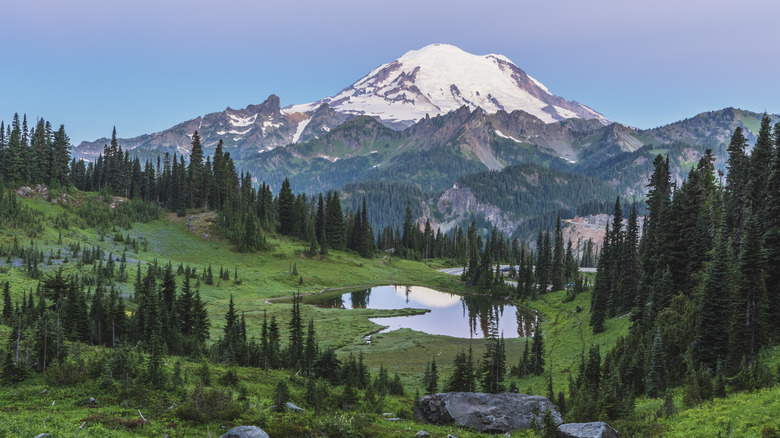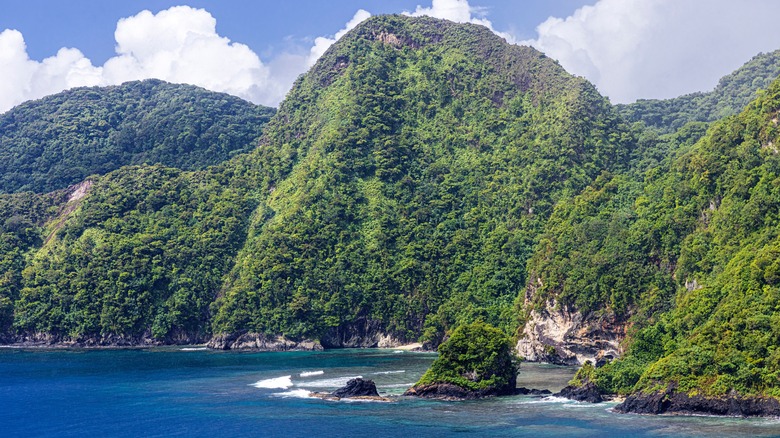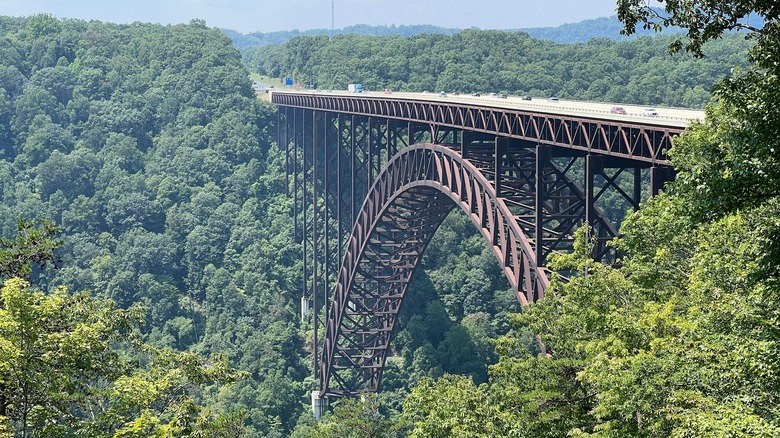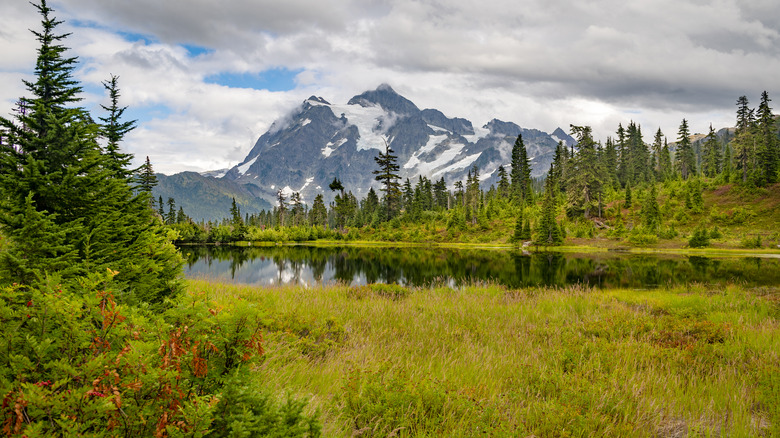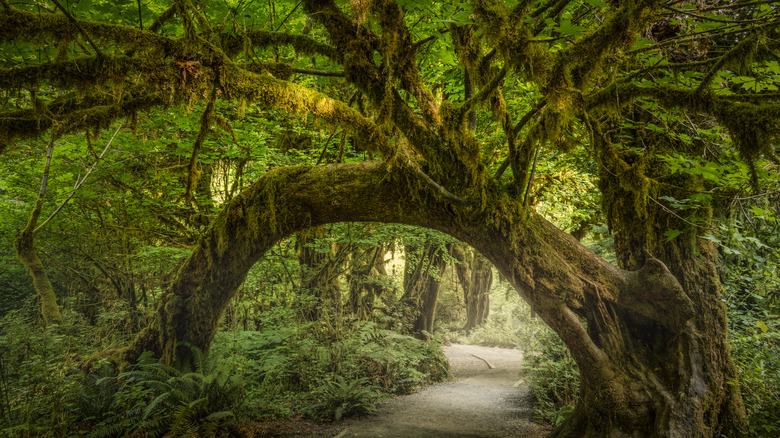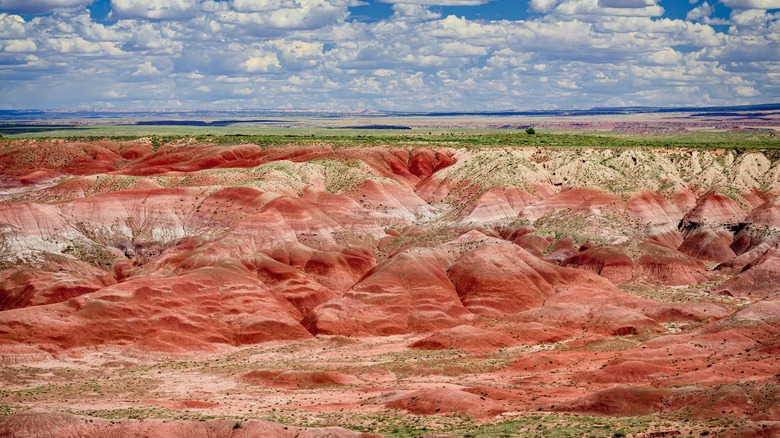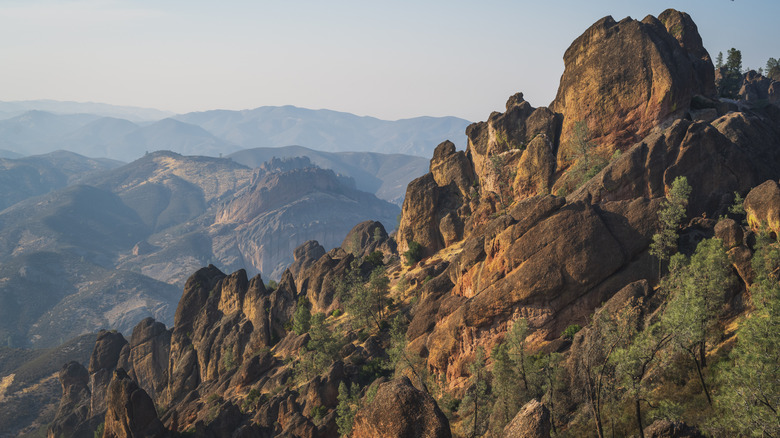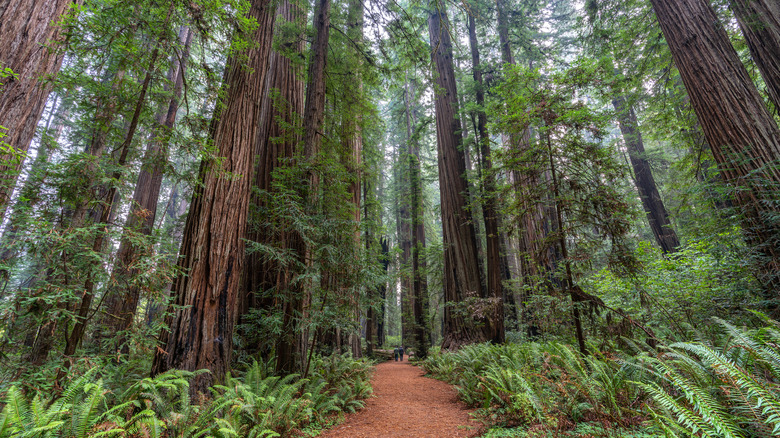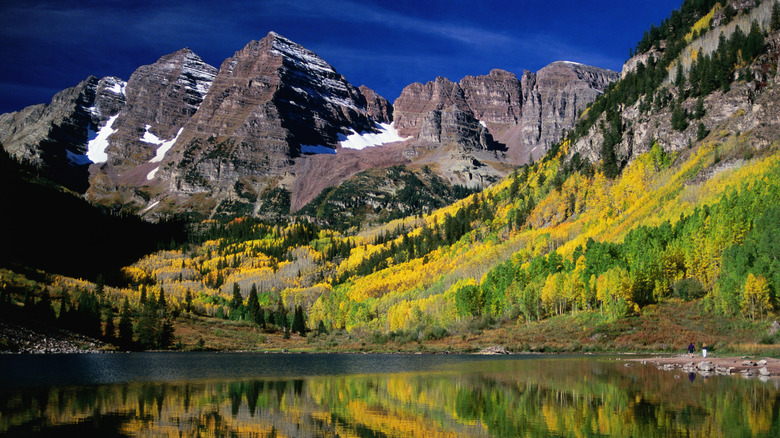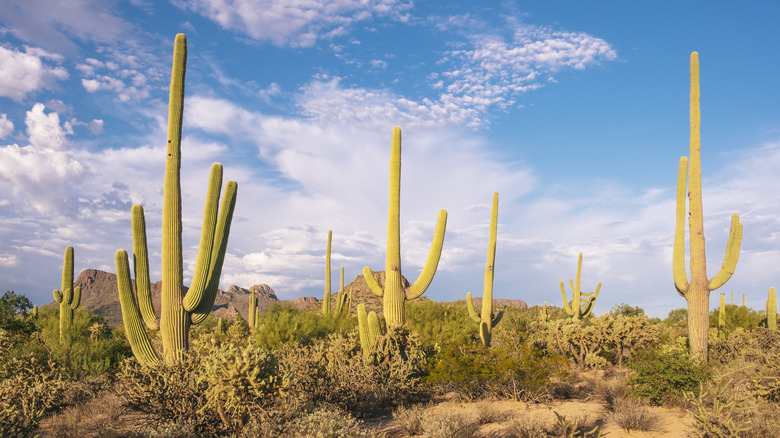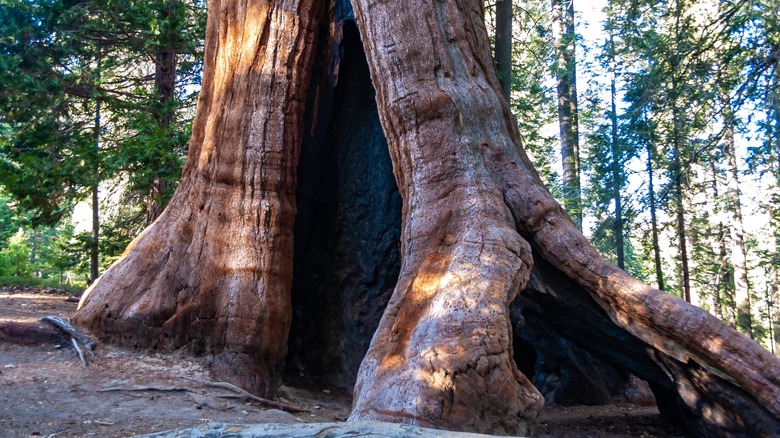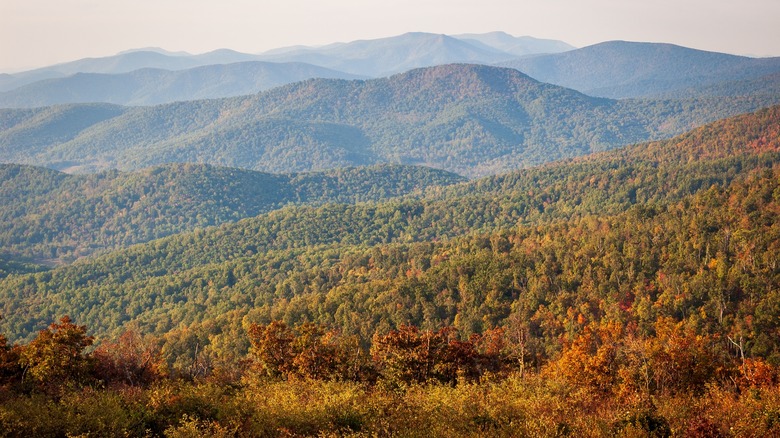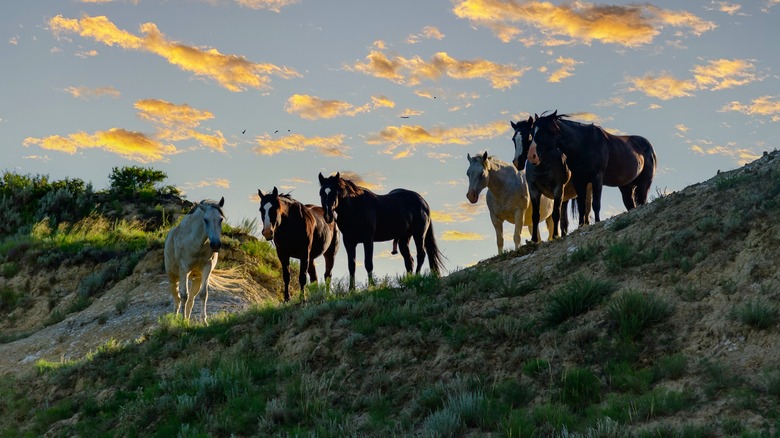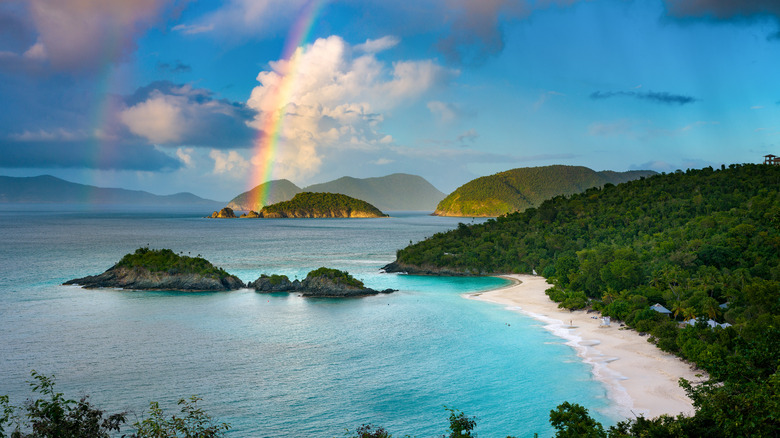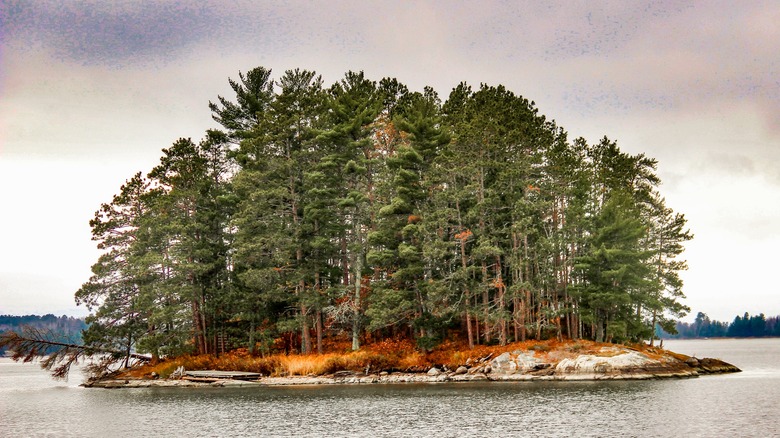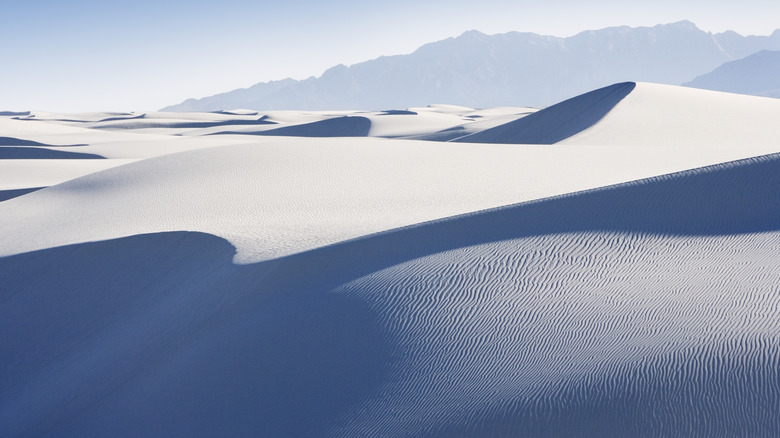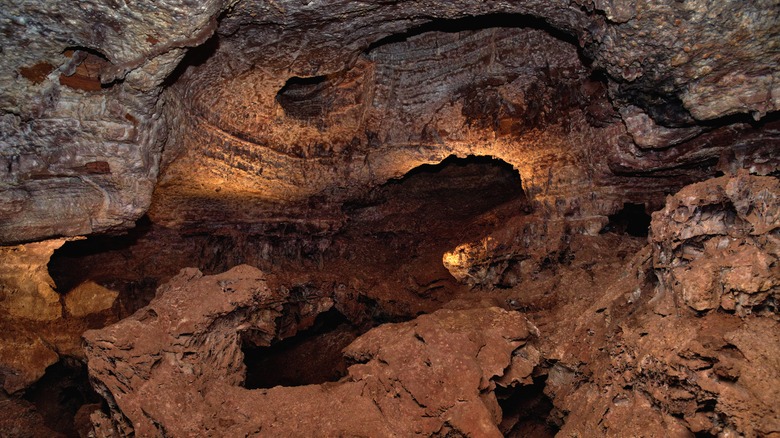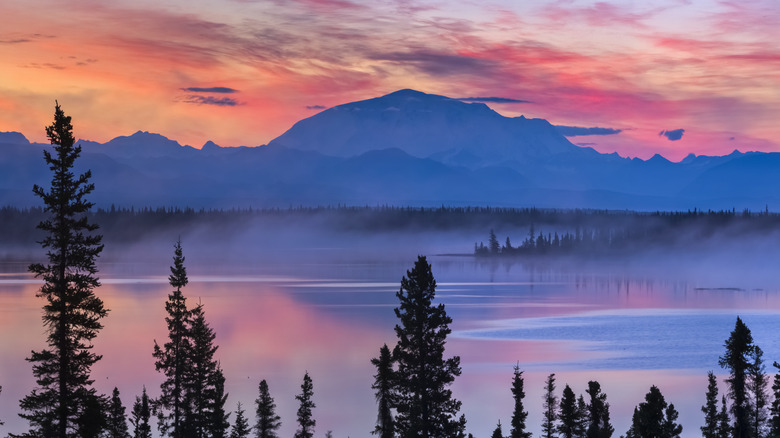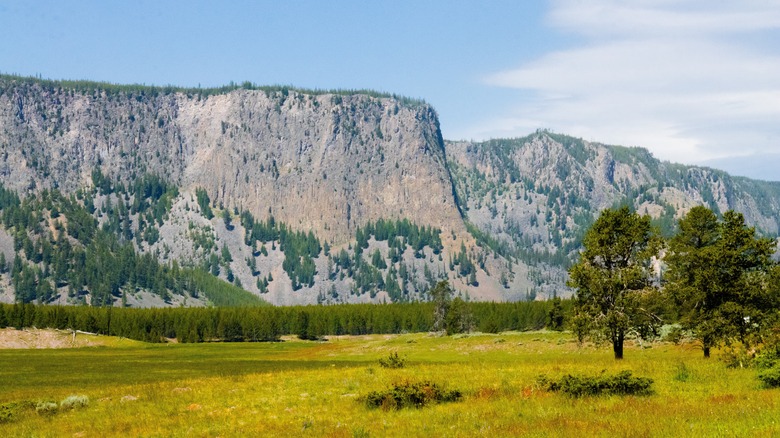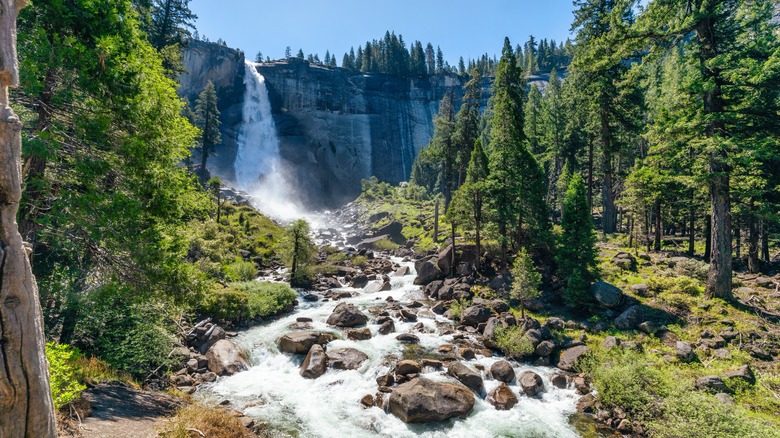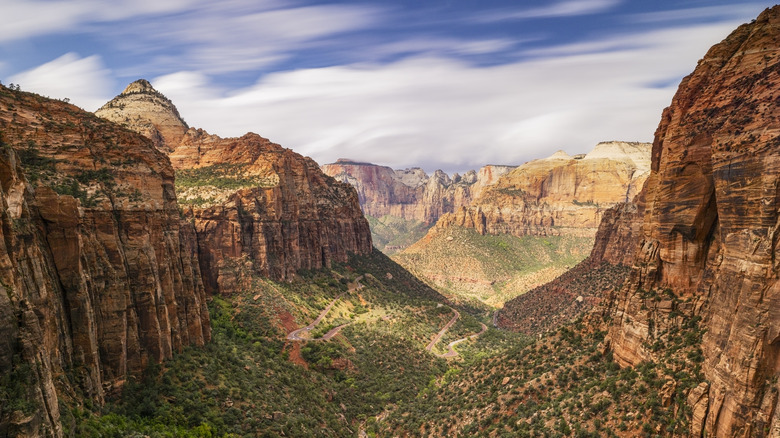A Complete List Of Every National Park In America
Established by President Woodrow Wilson in 1916, the United States National Park Service has been around for over 100 years, officially preserving some of the nation's most awe-inspiring and ecologically significant sites. These large swathes of land represent the tremendous variety of landscapes that the United States has to offer, from glacier-carved canyons and towering forests to tropical wetlands and snow-capped mountains. Nowadays, there are 63 national parks spread across 30 states and two U.S. territories, each more breathtakingly beautiful than the last. Below we take you to each and every American national park, highlighting all that they have to offer.
Acadia National Park, Maine
Acadia is the only national park in the Northeast, but it certainly earns its keep. Packed with rewarding hiking trails and picturesque coastline, it's a gem showcasing New England's natural beauty — especially if you visit when the trees are in their full autumnal glory.
Arches National Park, Utah
Arches National Park is, well, exactly what it says on the tin. This Utah-based beauty is populated with thousands of sandstone arches, each more breathtaking than the last.
Badlands National Park, South Dakota
The Badlands, despite their name, are not so bad. In fact, they're actually rather pretty. Still, between their unpredictable temperatures and lack of potable water, they're not the most hospitable for stranded visitors, so GPS and a full tank of gas are a must.
Big Bend National Park, Texas
Located in southwest Texas, along the Mexican border, Big Bend National Park protects a large portion of the Chihuahuan Desert that stretches into the United States.
Biscayne National Park, Florida
Most of the national parks in the United States are on land — not Biscayne National Park, though. Located in Biscayne Bay, and the oceans surrounding it, the majority of this park is composed of water, as it protects the local barrier reef.
Black Canyon of the Gunnison National Park, Colorado
Make sure to watch your step while you're exploring Black Canyon of the Gunnison National Park — it contains some of the steepest cliff faces in the entire country. In fact, the canyon is so deep that portions of it only get 33 minutes of daylight.
Bryce Canyon National Park, Utah
Bryce Canyon National Park is notable for its natural amphitheaters and extensive collection of hoodoos, which arethin spires that have been hewn out of rock by thousands of years of erosion.
Canyonlands National Park, Utah
Another day, another seemingly alien, yet stunning, Utah landscape. Canyonlands National Park was immortalized by author Edward Abbey, who called it, "the most weird, wonderful, magical place on earth — there is nothing else like it anywhere."
Capitol Reef National Park, Utah
Capitol Reef National Park was named for the domes that rest atop many of its white sandstone cliffs — which are similar in many ways to the dome on the Capitol Building in Washington, D.C — as well as reef-like formations along the cliffs.
Carlsbad Caverns National Park, New Mexico
Located in the heart of New Mexico, Carlsbad Caverns National Park contains an impressive cave system, including the Big Room, which is largest singular limestone chamber in all of North America.
Channel Islands National Park, California
Eight islands comprise the Channel Islands off the coast of California, and five of them are protected as part of the Channel Islands National Park. You can reach the islands by private boat or by utilizing the public ferry service.
Congaree National Park, South Carolina
Congaree might not be the most visited national park in America (in fact, it ranks among the bottom 10 in terms of annual visitors), but it has unique charms of its own — visitors can enjoy hiking and kayaking through its swampy terrain.
Crater Lake National Park, Oregon
Oregon's only national park, awe-inspiring Crater Lake is all that remains of the ancient Mount Mazama, which collapsed into a caldera after its last eruption over 7,000 years ago.
Cuyahoga Valley National Park, Ohio
Ohio may not be known for its national parks — in fact, Cuyahoga Valley is the only one it has to its name — but what it lacks in quantity it makes up for in quality. Cuyahoga Valley, with its picturesque waterfalls and rolling hills, receives nearly three million visitors annually.
Death Valley National Park, California and Nevada
Death Valley, as you might be able to gather from the name, isn't for the faint of heart. Located in the scorching deserts of California and Nevada, it's not uncommon for temperatures to reach 120 degrees Fahrenheit during the summer. In fact, it once registered a temperature of 134 degrees Fahrenheit — the highest ambient air temperature ever recorded.
Denali National Park, Alaska
The towering centerpiece of the Denali National Park is Denali (known as Mount McKinley until 2015, when it was changed to reflect its traditional Alaskan name), which, at 20,310 feet, is the tallest mountain in North America.
Dry Tortugas National Park, Florida
Once part of a Civil War-era prison that housed co-conspirators of the Abraham Lincoln assassination, Dry Tortugas preserves not just the Fort Jefferson military fortress, but the isolated Dry Tortugas islands of the Florida Keys.
Everglades National Park, Florida
Comprised primarily of tropical wetlands, the Everglades are home to a variety of endangered species, some of which, like the American crocodile and the Florida panther, you will hopefully not encounter face-to-face while on your visit.
Gates of the Arctic National Park, Alaska
Located in Alaska, Gates of the Arctic is the northernmost national park in the country. It features gorgeous vistas, but getting there will take some doing — there are no roads or maintained trails within the park, and it requires a hike of several miles to even reach its borders.
Gateway Arch National Park, Missouri
America's only urban national park (a decision made with some controversy, since it doesn't have a conservation component), the Gateway Arch is located smack dab in the middle of St. Louis, Missouri. Completed in 1965, the sprawling arch represents the gateway to the west, reflecting St. Louis's role in America's expansion.
Glacier Bay National Park, Alaska
Located along the northern coast of Alaska, this stunning national park, like Gates of the Arctic, has little by way of roads or trails. However, its position on the water ensures that it still receives plenty of visitors each year, the majority of which arrive by cruise ship.
Glacier National Park, Montana
Glacier National Park is one-half of an international venture — across the Canadian border lies the Waterton Lakes National Park, and the two make up one giant park. With a landscape hewn by Ice Age glaciers, it contains several mountains, hundreds of lakes, and 25 active glaciers.
Grand Canyon National Park, Arizona
The Grand Canyon is one of the most recognizable of the national parks in the United States, and without a doubt one of its most heavily trafficked — it receives nearly 5 million visitors annually. A trip here is the ultimate bucket list item for many travelers.
Grand Teton National Park, Wyoming
Grand Teton National Park is only about 10 miles away from its more famous sister, Yellowstone, but it has its own unique features that make it a must-visit — chief among them the Grand Teton mountain that the park is named for.
Great Basin National Park, Nevada
Great Basin National Park is home to ancient forests, caves, and wildlife of all sorts, but you'll really love the views at night — thanks to its remote nature, the night skies are incredibly clear and vibrant.
Great Sand Dunes National Park, Colorado
Although Colorado is mostly known for being home to a large portion of the Rocky Mountains, it also has the Great Sand Dunes National Park, which features the tallest sand dunes in North America.
Great Smoky Mountains National Park, North Carolina and Tennessee
Encompassing a large section of the Blue Ridge Mountains in North Carolina and Tennessee, the Great Smoky Mountains National Park feature some of the most picturesque landscapes in the eastern United States.
Guadalupe Mountains National Park, Texas
Home to the famous El Capitan landmark, Guadalupe Mountains National Park represents the best that the southwestern corner of Texas — where the state begins to take on the desert landscape of its New Mexican neighbor — has to offer.
Haleakala National Park, Hawaii
With an active volcano on site that simmers intimidatingly over its surroundings, the landscape of the Haleakala National Park on Maui is nothing if not dramatic. It's also home to the highest number of endangered species of any U.S. national park.
Hawai'i Volcanoes National Park, Hawaii
If you want to visit Hawai'i Volcanoes National Park, your first step is to find a lull in volcanic activity — it has experienced eruptions as recently as September 2024, which can understandably impact tourism.
Hot Springs National Park, Arkansas
The refreshingly unique Hot Springs National Park originally found fame for its perceived health benefits — for hundreds of years, people have visited the hot springs in the hopes that the thermal waters would cure a whole range of diseases.
Indiana Dunes National Park, Indiana
Located along the shoreline of Lake Michigan, the Indiana Dunes National Park has a variety of dunes, marshes, bogs, and wetlands for visitors to explore. It's Indiana's only national park and the third youngest in the country, established in 2019.
Isle Royale National Park, Michigan
Isle Royale is miles away from the coastline of Lake Superior, and its remoteness makes it a charming destination — there are no roads on the island, and if you're lucky, you might even see moose swimming in the surrounding waters.
Joshua Tree National Park, California
The stars of this show are undoubtedly the titular Joshua trees, a unique yucca plant that provides a stark contrast to the park's desert landscape. Although Joshua Tree National Park is just a few hours from Los Angeles, it feels like another planet entirely.
Katmai National Park, Alaska
Katmai National Park, one of Alaska's most distinctive national parks, is home to the Valley of Ten Thousand Smokes, a landscape that seems almost alien, thanks to volcanic ash flow from an eruption back in 1912.
Kenai Fjords National Park, Alaska
As one might expect for a park on the Alaskan coast, ice is the name of the game in the Kenai Fjords National Park — it's home to the Harding Icefield and some of the most stunning fjords carved out by glaciers in North America.
Kings Canyon National Park, California
Filled with the rugged peaks of the Sierra Nevada mountain range, Kings Canyon National Park is adjacent to Sequoia National Park, creating one of California's most picturesque double acts that can stand up against the much more popular Yosemite any day of the week.
Kobuk Valley National Park, Alaska
Back in the 1980s, this park was created in part to protect the Great Kobuk Sand Dunes, which can reach heights of up to 100 feet. Its labyrinthine rivers provide a terrific backdrop for intrepid travelers who make the journey.
Lake Clark National Park, Alaska
Alongside the stunning Lake Clark that the park is named for, it also features two active volcanoes. But if you want to get there, you'll have to do some work — it can only be reached by boat or plane.
Lassen Volcanic National Park, California
Volcano enthusiasts should find plenty to spark their interest here — while Lassen Peak hasn't erupted since 1915, it is the largest plug dome volcano in the entire world, and much of the rest of the criminally underrated Lassen Volcanic National Park is still active.
Mammoth Cave National Park, Kentucky
Stretching for hundreds of miles underneath the grounds of Kentucky, Mammoth Cave is the longest cave system on the planet. It's not only a national park, but also a World Heritage Site and an internationally recognized Biosphere Reserve.
Mesa Verde National Park, Colorado
Mesa Verde National Park has not just ecological value, but cultural value as well. It preserves ancient ancestral sites of the Pueblo people, many of which have been hewn into walls of caves in present-day Colorado. The most iconic sight is Cliff Palace, which dates back to the 1100s and has over 150 rooms.
Mount Rainier National Park, Washington
How often do you get to go to an active volcano in the United States? (If that's the kind of thing you're into, that is.) Mount Rainier is the centerpiece of this national park, looming ominously over the Cascade Mountain Range.
National Park of American Samoa, American Samoa
One of the few national parks located in a U.S. territory rather than a state, the National Park of American Samoa stretches across four islands in the Pacific, and is a dream destination for coral reef enthusiasts.
New River Gorge National Park, West Virginia
Adventure seekers, take note — New River Gorge National Park has some of the most exciting whitewater rafting you'll find anywhere in the United States. It's also the newest national park, only established in 2020.
North Cascades National Park, Washington
You'll find in North Cascades National Park more than just some pretty mountains — it's home to an extensive glacial system, as well as tremendous biodiversity, especially in regards to the flora found within the park.
Olympic National Park, Washington
Nestled on the Olympic Peninsula, Olympic National Park is home to a temperate rainforest alongside the Pacific coast, just south of the border between Canada and the United States. It became a designated UNESCO World Heritage Site in 1981.
Petrified Forest National Park, Arizona
Surrounded by the stunningly crimson Painted Desert, the Petrified Forest National Park delivers on its name — there, you'll find examples of petrified wood that date back hundreds of millions of years.
Pinnacles National Park, California
Pinnacles National Park once housed an active volcano — don't worry, it last erupted 23 million years ago — but nowadays it's best known for its population of the critically endangered California condor, which has been re-established in the region through conservation efforts within the past few decades.
Redwood National Park, California
When you go to Redwood National Park, your first priority has to be to explore the large forests of old-growth coast redwoods, an endangered tree species. Their awesome height has to be seen to be believed.
Rocky Mountain National Park, Colorado
Immortalized by a popular John Denver song, the Rocky Mountain National Park sits on the Continental Divide and protects large swathes of Colorado's mountain terrain. Make sure to go for a drive along Trail Ridge Road, the highest paved road in the country — just watch out for moose along the way.
Saguaro National Park, Arizona
Located in the southwestern corner of Arizona, the Saguaro National Park highlights the stark and desolate beauty of the Sonaran Desert, as well as its iconic Saguaro cactus.
Sequoia National Park, California
The Sequoia National Park is home to seemingly endless forests, but its crown jewel is the staggeringly-massive General Sherman, which, with a diameter of 36 feet, is the largest single-stem tree on Earth.
Shenandoah National Park, Virginia
Nestled within the Blue Ridge Mountains of Virginia, the most famous attraction of the Shenandoah National Park is Skyline Drive, a 105-mile-long road that runs along the length of the park.
Theodore Roosevelt National Park, North Dakota
Named for the president who helped spearhead the national park movement in the United States, the Theodore Roosevelt National Park occupies a portion of the scenic badlands of North Dakota, preserving its natural beauty as its namesake intended.
Virgin Islands National Park, Virgin Islands
One of the few national parks not located in a U.S. state, the Virgin Islands National Park preserves large swatches of coastline, marine life, and tropical rainforest on the island of Saint John and its surrounding waters.
Voyageurs National Park, Minnesota
Named for the French fur trappers who were some of the first Europeans to set foot in Minnesota, Voyageurs National Park is a dream destination for lovers of lakes and water sports, both of which can be found in abundance.
White Sands National Park, New Mexico
You'd be forgiven for thinking, upon setting foot in White Sands National Park, that you had somehow been transported to an alien planet. But these unique dunes are entirely earthly, and comprised of gypsum crystals.
Wind Cave National Park, South Dakota
The caves at Wind Cave National Park have a unique feature you're unlikely to find elsewhere — their calcite formations are known as boxwork, which gives it a fascinating honeycomb-like structure.
Wrangell-St. Elias National Park, Alaska
Wrangell-St. Elias National Park is home to some of the tallest mountains in the United States, including Mount St. Elias, which straddles the border between Canada and Alaska.
Yellowstone National Park, Idaho, Montana, and Wyoming
Yellowstone is undeniably a trailblazer: It's not only the oldest national park in the United States, established in 1872, just a handful of years after the end of the American Civil War, but it's generally accepted to be the oldest national park in the entire world.
Yosemite National Park, California
When you visit Yosemite in California, you'll be spoiled for choice when it comes to incredible views — it lays claim to the granite monolith El Capitan, Cathedral Peak, and Half Dome, amongst many other awe-inspiring sights.
Zion National Park, Utah
Zion National Park straddles four different unique landscapes, combining desert, woodland, forests, and riverbanks, all of which allow a surprising level of biodiversity to establish itself. The park's stated purpose is to protect the striking geology of the region, and striking it surely is.
